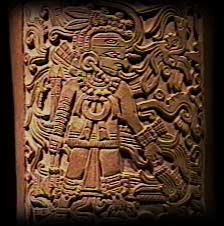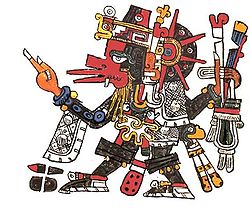Located in the rear center of the great Ciudadela compound, the
Temple of Quetzalcoatl is one of the largest pyramidal structures at
Teotihuacan.
The temple facade represents serpents passing through a facade of
circular mirrors (Taube 1986, 1988). Two forms of serpents are present,
Quetzalcoatl and an ancestral form of the Xiuhcoatl. In this respect,
the Temple of Quetzalcoatl facade may be compared to the Postclassic
wind temple of Ehecatl-Quetzalcoatl, which also appears with mirrors and
serpents (Taube 1986).
Quetzalcoatl (pronounced Keh-tzal-coh-AH-tl) was a creative god,
who – according to the Legend of the Suns –ruled over the second era
of Aztec creation. He was also the patron of arts and knowledge and,
according to Aztec religion; he was the god who provided humans with
their first corn to plant.
Among the Classic Maya, the figure of a feathered serpent is illustrated in
many stone monuments and murals, and is often related to the worship of
royal ancestors. During the Epiclassic period the cult of the
Feathered Serpent spread dramatically in Mesoamerica. In Central Mexico,
other centers where the cult of the feathered serpent is widespread are
Xochicalo, Cholula, and Cacaxtla. The most famous example of this widespread
cult is the site of Chichen Itza in the Yucatan Peninsula and its connections with
the central Mexican site of Tula, capital of the Toltecs. According to local and
colonial sources, Quetzalcoatl-Kukulcan (by its Maya name) arrived in the
Yucatan bringing with him a new set of religious and political practices
associated with militarism, and human sacrifices. These themes are easily
recognizable in the architecture and sculptures of Maya sites such as
Chichen Itza and Mayapan For the Postclassic period, the Aztecs/Mexica
revitalized the cult of Quetzalcoatl, which was also associated to the
figure of Ehecatl, the wind god, and to the planet Venus.
In the natal chart Quezlecoatl represents the warrior within, that fights
for equality and justice for all mankind. His position and aspects show
the fights and battles we will overcome in life.

Tezcatlipoca means Lord of the smoking mirror.
The Mexica people (name Aztecs used to refer to themselves) made mirrors of varying sizes with cut iron pyrites and obsidian (a volcanic glass). They were sometimes used in divination and healing practices. For example, if a child was suffering from ‘soul loss’ the healer would look at the reflection of the child’s image in a mirror or a container with water. If the image were clear the child would soon recover; if it were shadowy, the soul had been lost. Like the Mexica, some people in parts of Mexico today believe that ‘soul loss’ is a cause of illness.
Mirrors were also associated with Tezcatlipoca, the Mexica god of rulers, warriors and sorcerers. His name can be translated as ‘Smoking Mirror’. In many depictions during the Postclassic period (AD 900/1000-1521) his foot is replaced by a mirror.
The name ‘Smoking Mirror’ derives from the Nahuatl (Mexica) word tezapoctli, meaning ‘shining smoke’ and representations of Tezcatlipoca are typically characterised by distinctive black stripes on the face and a smoking mirror generally displayed in his headdress, at his temple or in place of a torn-off foot.
In the natal chart Tezcatlipoca depicts our ability to see what lies hidden beneath the surface our ability to look honestly within our own souls and that of others. This asteroid gives us an ability to intuitively feel what lies behind the actions of others. As God of the night he confers the ability to see through the darkness and follow the path before us.


